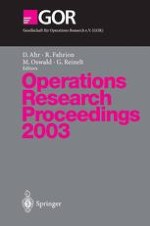This volume contains a selection of papers referring to lectures presented at the symposium "Operations Research 2003" (OR03) held at the Ruprecht Karls-Universitiit Heidelberg, September 3 - 5, 2003. This international con ference took place under the auspices of the German Operations Research So ciety (GOR) and of Dr. Erwin Teufel, prime minister of Baden-Wurttemberg. The symposium had about 500 participants from countries all over the world. It attracted academians and practitioners working in various field of Opera tions Research and provided them with the most recent advances in Opera tions Research and related areas in Economics, Mathematics, and Computer Science. The program consisted of 4 plenary and 13 semi-plenary talks and more than 300 contributed papers selected by the program committee to be presented in 17 sections. Due to a limited number of pages available for the proceedings volume, the length of each article as well as the total number of accepted contributions had to be restricted. Submitted manuscripts have therefore been reviewed and 62 of them have been selected for publication. This refereeing procedure has been strongly supported by the section chairmen and we would like to express our gratitude to them. Finally, we also would like to thank Dr. Werner Muller from Springer-Verlag for his support in publishing this proceedings volume.
